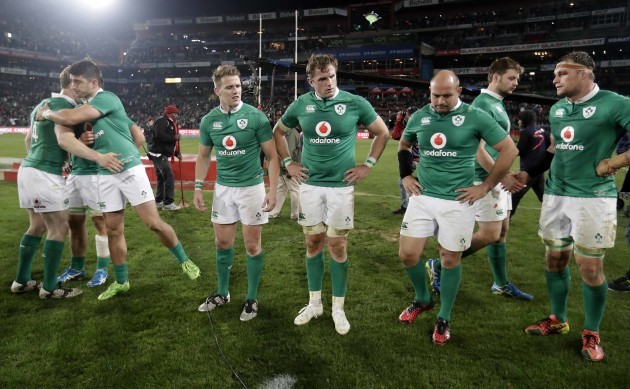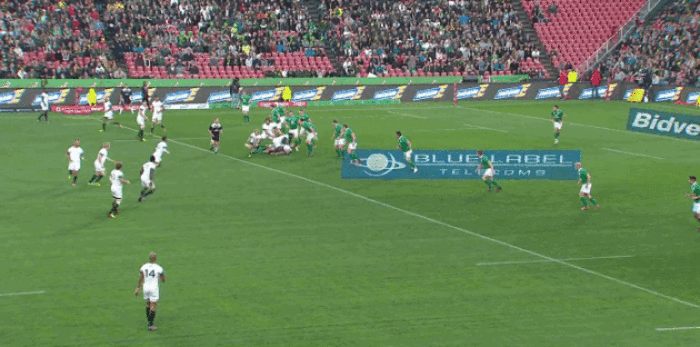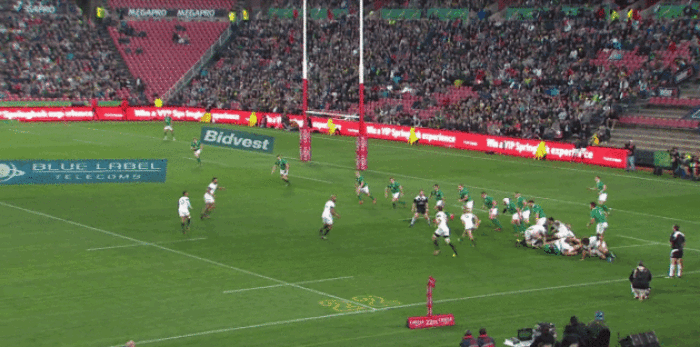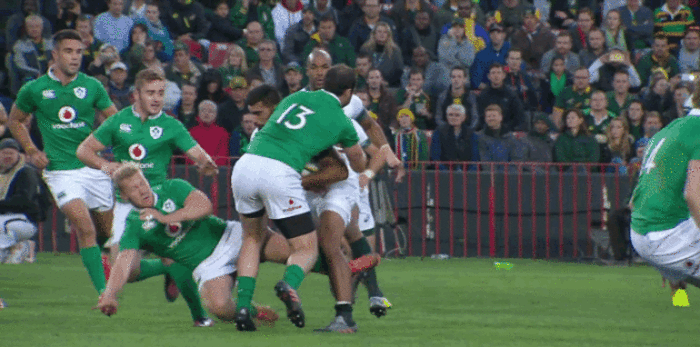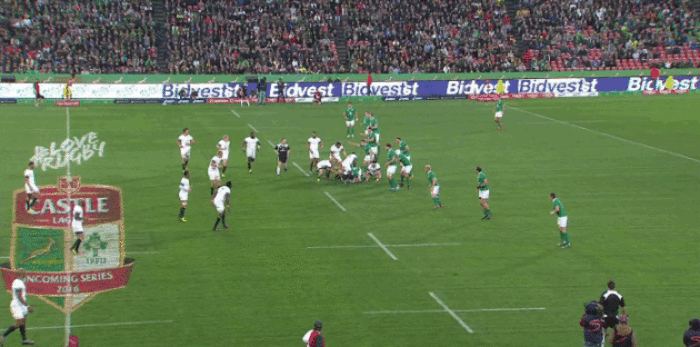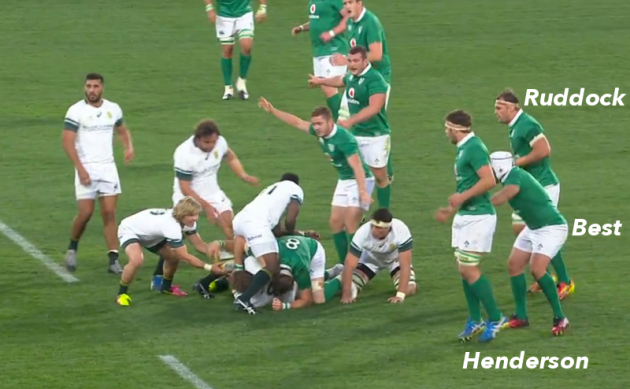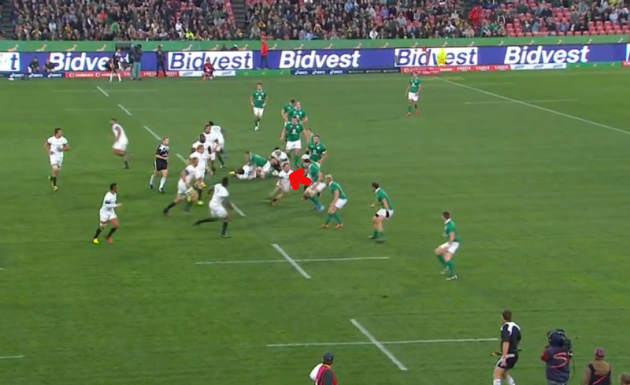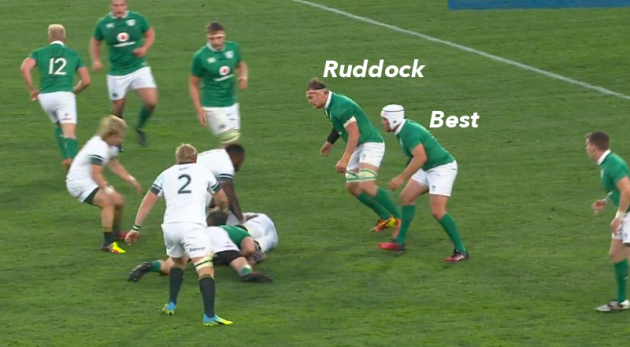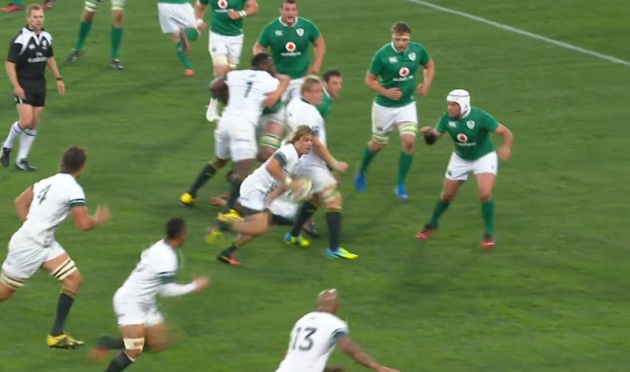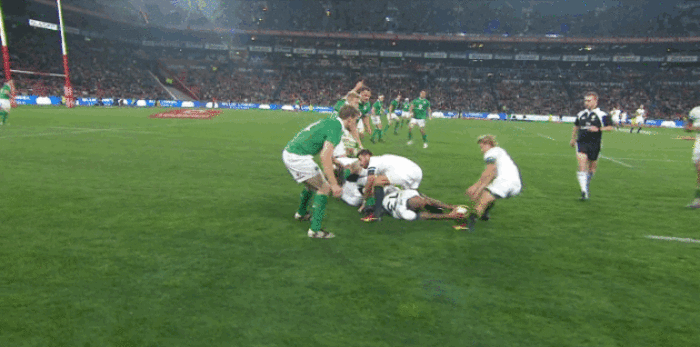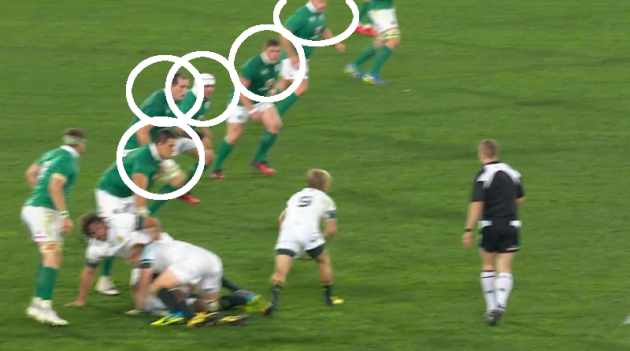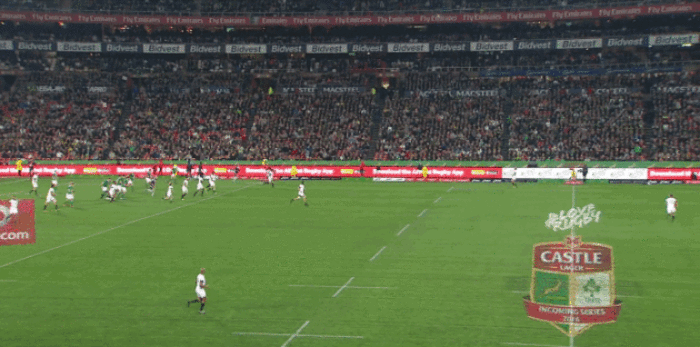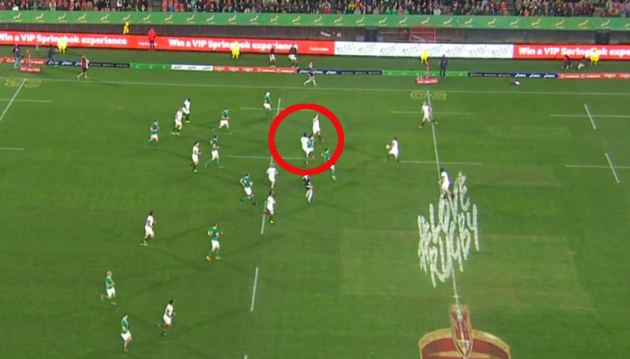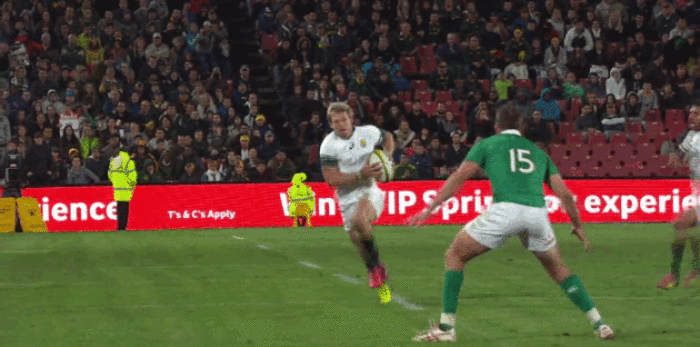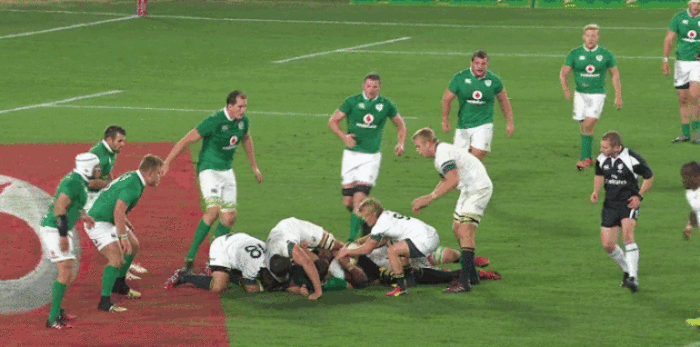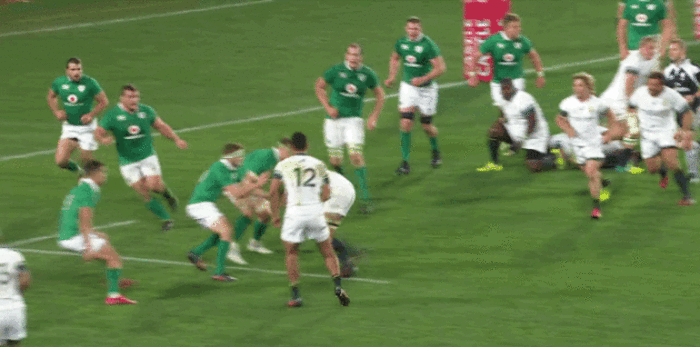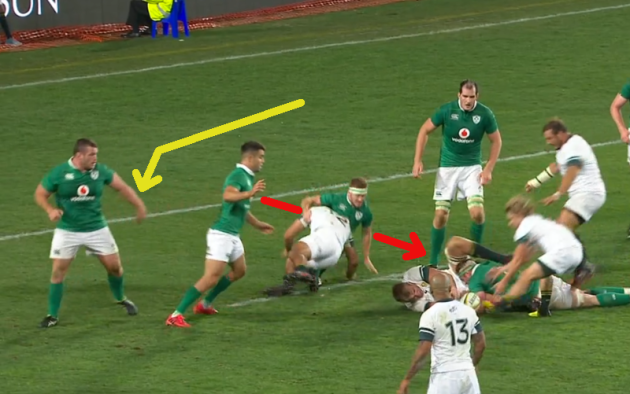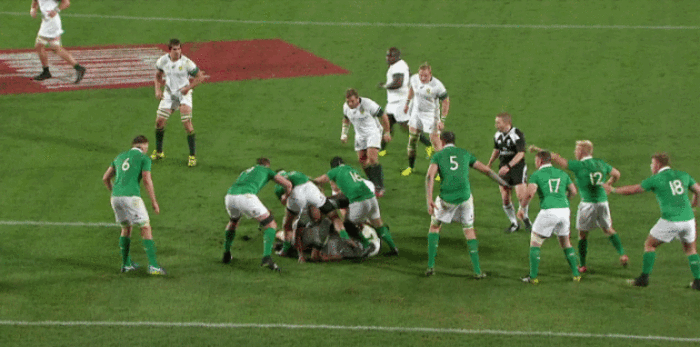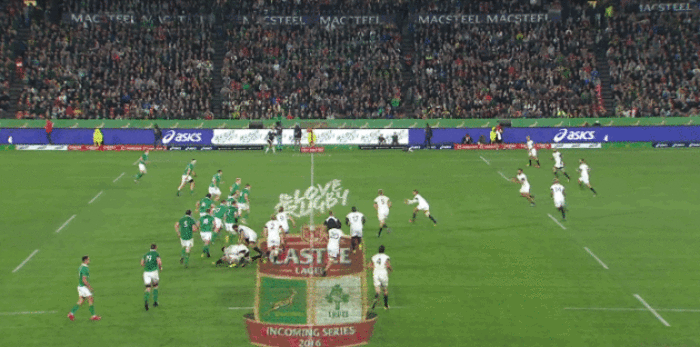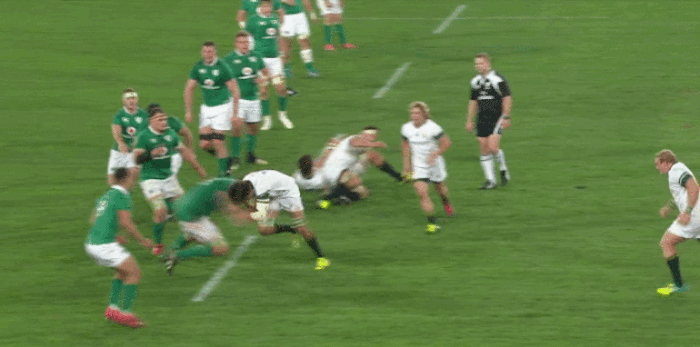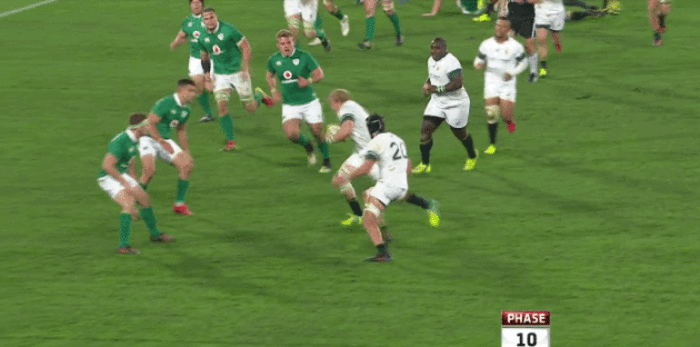HAVING IMPRESSIVELY BUILT a 19-3 lead in the first half of Saturday’s second Test against the Springboks, Ireland simply could not withstand a second-half onslaught from the hosts.
The Boks scored 29 points in the closing 25 minutes of the game but the signs of the remarkable turnaround were clear from almost immediately after the half-time break.
Ireland could not cope as Allister Coetzee’s side produced an impressive attacking transformation to repeatedly stretch the defence. The breaking point arrived with Ruan Combrinck’s 56th minute try and Ireland could not stem the tide thereafter.
The altitude factor certainly appeared to contribute greatly to the shift but Ireland’s review of the game is unlikely to have centred on that element.
Instead, they will have been disappointed with specific aspects of the defensive effort, all of which defence coach Andy Farrell is sure to have highlighted as fixable ahead of the third Test.
Strip show
Limiting the Boks to just three points in the opening half underlines that the defensive effort from Ireland was strong. Indeed, a muscular defence was part of an excellent first-half display from Joe Schmidt’s men.
As with the first Test, we saw a number of strips in contact from Irish defenders as they targeted the intermittent lack of ball security from the Boks. One of the biggest shifts after half time was in the technical quality of the South Africans’ carry but Ireland punished them in the first half.
Paddy Jackson is the man to make the turnover in the instance above, ripping the ball clear of Siya Kolisi’s grasp as the back row launches himself straight at the Ulsterman.
Jackson’s high tackle focus and intent to grapple for the ball is aided immensely by the swift tackle Quinn Roux makes from the inside, ensuring that Kolisi’s leg drive is cut off as he worries about the Ireland out-half’s strip.
Clearly, this is a technique Ireland have been working on under Farrell but, as the Englishman might say himself, mindset is key. It’s an aggressive form of attacking the opposition when they are in possession.
There is a degree of ‘risk’ involved in targeting the ball as Robbie Henshaw does above after Stuart Olding has been fended into the ground by Damien de Allende. It’s a proactive defensive technique, however, one that sees Irish defenders take the contest to the carrier.
It brings the slight danger of missing the ball and simply allowing the carrier to make yards with their leg drive. However, Ireland have largely shown accuracy in the technique, of which we get a fine example from Henshaw.
Henshaw’s explosive action is one-handed in this instance, as he dynamically drags his left arm from underneath the ball upwards through the hands of de Allende to strip it loose.
Both of these moments of defensive proactivity from Henshaw and Jackson come in excellent attacking positions for the Boks, denying them early opportunity to establish themselves.
Decisions
While Ireland’s superb tactical kicking ensured the Boks didn’t enjoy the territory that Coetzee craved in the first half, there were glimpses of their threat with ball in hand.
Generating linespeed from defensive rucks in midfield is often very difficult to do but above we can see Ireland sitting off in a manner that would become much more apparent in the second half.
The threat of Faf de Klerk is key for the Boks here.
He runs an arcing line to the right of the ruck to take him outside the pillar defender, Rhys Ruddock.
Essentially, the scrum-half is Rory Best’s ‘man’ here. It’s the duty of that second defender out from the ruck to take the darting scrum-half.
However, Iain Henderson is slow to get his spacing outside Best set and we can see above that de Klerk is immediately eyeing an opportunity.
Henderson is ball watching when the defence would benefit more from him being concerned about what’s going on further out in the Springboks’ attacking line. De Klerk superbly exploits the situation by arcing out towards Henderson.
We can see in the clip that Best is in position to tackle de Klerk – as the system calls for – but Henderson is lured into turning his shoulders inwards to deal with the Boks scrum-half.
Suddenly, there is sliver of space open on Henderson’s outside and de Klerk pops the ball off for Pieter-Steph du Toit to gather and surge into it on the inside of Olding.
Henderson biting in forces Olding to sit off du Toit – he may wonder if he should have continued to come forward more aggressively – and the big Bok lock wins the collision to ensure he can get his hands free for an offload, adding a further stress for Ireland’s defence.
When Kolisi is grounded, we see another questionable decision from an Irish defender close to the ruck.
Tendai Mtawarira arrives over Kolisi to act as the guard for the Boks and Ruddock would perhaps be best served by simply ignoring the breakdown and getting into the defence on Ireland’s left-hand side of the breakdown.
Instead, Ruddock feels that he can make an impact by counter rucking against Mtawarira in the hope of disrupting the ball. His effort is unsuccessful and now Best is left to defend against a second de Klerk snipe – only this time he starts as the pillar.
Best begins from a tighter position and is always going to struggle against de Klerk’s pace here. The presence of so many Boks coming around the corner outside the scrum-half draws left wing Craig Gilroy out and Best is left exposed in defence.
Having had Ruddock push him out an extra metre could make a huge difference in this case. As it is, Best does well to slow de Klerk and the back-up support of Jared Payne and the hard-working Henshaw mean it’s unlikely to be a big bust anyway.
Nonetheless, the Boks show hints of the threat that would take over in the second half, albeit in a slightly different manner.
Transformation
Coetzee made his most impressive impact as Boks coach yet at half time in this game, introducing the in-form Lions pair of Warren Whiteley and Ruan Combrinck.
Lions tighthead prop Julian Redelinghuys followed minutes later and with halfbacks Faf de Klerk and Elton Jantjies – both Lions – already on the pitch, the Boks’ attacking tactics shifted towards what has been making the Johannesburg Super Rugby franchise such an effective force all season.
The tempo was lifted with quick lineouts and a renewed focus on clearing Irish bodies from the breakdown, while the South Africans also built notable width into their game plan by introducing a more clearly-defined 1-3-3-1 shape.
Coming away from the left touchline in the 41st minute, we see above that the Boks’ first pod of three forwards carries off de Klerk.
On the next phase, out-half Jantjies links the ball to the second pod of three forwards, where we see Eben Etzebeth passing out the back to Combrinck – almost certainly something the Boks lock would not have done in the first half or first Test.
The shape from the Boks is simple but effective and there are two things in particular that allow Combrinck to make good gains here.
Firstly, Francois Louw runs good interference ahead of the ball outside Etzebeth in that second pod of forwards. He’s initially a threat himself with a possible tip-on pass from Etzebeth but the ball goes out the back to Combrinck.
Louw continues his run upfield, ‘staying big’, and bumps Henderson backwards out of the Ireland line.
As that happens, Murray is concerned about the width of the Boks attack. That width is provided by two back row forwards in Kolisi and Whiteley.
Their mere presence ensures Murray can’t immediately turn back in as Henderson gets bumped. Instead, the combined effect is that Combrinck can surge forward into the space between Henderson and Murray before they react to bring him to ground.
This particular thrust is swiftly followed by Willie le Roux breaking up the left and offloading to Lionel Mapoe, although the passage ends with Kolisi knocking-on in Ireland’s 22.
Two passes from the Boks in the instance above remove five Ireland defenders from the equation and it’s something that was notable throughout the second half.
Despite the Boks setting up with width here to play off out-half Jantjies, Ireland remain tight to the ruck and are therefore chasing the ball hard. That, of course, leads to some of the fatigue that reduced Ireland’s effectiveness in the tackle.
Farrell will have been looking at Ireland’s defensive spacing as a work-on for the third Test.
The very next Boks attack concludes with le Roux’s pass going into touch but these opening exchanges of the half proved to be a warning sign rather than a continuation of the South Africans’ wastefulness.
Shepherds
The first South African try arrived from a quickly-taken lineout by Combrinck – very much part of the Boks’ second-half plan.
The key aspect of this score is the manner in which the Boks’ retreating forwards remove Murray as a possible tackler of le Roux as the fullback hares back at Ireland.
Kolisi is the man to make contact with Murray as the scrum-half attempts to react to le Roux’s change of angle towards the touchline, essentially closing off the space for Murray to track le Roux.
Redelinghuys, who actually gets his hand up to signify the attacking opportunity, is thinking along the same lines as Kolisi and he makes a similar retreating run to ensure that Murray is completely shepherded out of the scenario.
With Combrinck supporting on his outside, the fullback is now one-on-one with loosehead prop Jack McGrath and scorches through the line, drawing in Gilroy and feeding his right wing.
It’s a difficult covering tackle for Jackson but he will have been disappointed with the manner in which he was beaten.
The touchline is Jackson’s friend in this instance and he ideally wants to make a tackle on his left shoulder to drive Combrinck towards it.
However, with Jackson sprinting hard to track across, Combrinck produces a superbly-timed step back inside off his right foot to bring the tackle onto Jackson’s right shoulder.
The Ireland out-half cannot get any power into a tackle on that side and the muscular Lions wing dominates the collision to allow himself to finish.
Turnaround
One of two exit failings by the Boks in the second half provided Ireland with the platform from which to respond almost immediately with Jamie Heaslip’s try from the maul, but the hosts were undeterred.
Their width continued to expose Ireland and draw them into deeper fatigue.
It’s Combrinck who does the damage again in the example above but Ireland will ask questions about their numbering-up in defence.
As the clip above begins, Whiteley is carrying in midfield directly from a four-man lineout.
Below, we can see that Donnacha Ryan is indicating for the players on his inside to fold around the corner and add an additional body to that side of the defensive line.
Virtually the entire Boks team has worked around the corner – or were already situated there – meaning there is little threat on Ireland’s right side of the tackle zone. Ryan is indicating for at least one defender to fold but it doesn’t happen.
The ruck ball is relatively speedy but even still just that one additional body folding to the left and pushing every other defender a little wider could have allowed Gilroy to get his hands on Combrinck, rather than Payne having come forward to deal with the right wing.
Combrinck’s physical dominance – after being released by the clever set-piece attack – is symptomatic of the second half for Ireland.
The poor tackle technique from Payne – he plants his feet early and passively goes high on Combrinck – also tells a story of Ireland’s fading in that area. Whereas their tackle technique had been superb in the first Test and first half in Johannesburg, they drastically declined in this area thereafter.
Moments after Payne is steamrolled, replacement Finlay Bealham is the man to miss the tackle.
The tighthead appears to momentarily lose focus and a simple inside pass sees him beaten, with Best on his outside also reacting late. It’s the kind of basic error that simply cannot be made in Test rugby and suddenly another Boks score looks inevitable.
It arrives two phase later, with Whiteley – having waited in the wings under the improved wide attacking shape – the man to dot down.
The clearout from de Allende on Jackson is crucial here, as it lures Murray in towards the breakdown just as McGrath folds around the corner to get into the defensive line.
Whiteley then targets that exact space with a dynamic step back inside both Andrew Trimble and McGrath, straightening and reaching out to score before Toner can cover across.
Sealing the comeback
The Boks were now rampant and their third try followed soon after, with more width and intelligent set-piece attack having allowed Coetzee’s side to regain strong field position.
A free-kick at scrum time against Ireland’s replacement front row provided the Boks with a five-metre shot at the tourists and they scored within two phases.
We get a glimpse of the aforementioned danger of going in high looking for the strip here, as Jackson is blasted aside by the brilliant du Toit on his way to the tryline.
Ruddock is the primary tackler as Jackson targets the ball but he slips down du Toit’s leg as the lock, who moved to the blindside flank, turns on his explosive power to surge over from close range.
The onslaught was not complete just yet, however.
The Boks’ winning try stems from an excellent Etzebeth steal of the Irish lineout near halfway and they burst into their phase play to show off the improved ball carrying that was a feature of their comeback.
Coetzee has mentioned the ‘shoulder battle’ in relation to ball-carrying during this series and it’s quite clear that his message is getting through to his players as we see de Allende drop his shoulders into Olding as the Ireland centre looks to tackle.
De Allende’s low body position allows him to transmit power into the contact and it’s remarkable how similar his carry above is to the one for the winning try several phases later.
Along with the improved carry, the Boks’ second-half clearout was much better and we get an example as this passage moves wide to the left.
Adriaan Strauss gets exceptionally low here to win the breakdown ‘shoulder battle’ against Murray, who has jackaled over the ball. The Ireland scrum-half believes he’s done enough to earn reward but referee Angus Gardner feels he has “missed it.”
Strauss’ aggression and body height win out on his occasion.
The Boks’ width in their 1-3-3-1 shape sees them stretch Ireland – now at 14 men with Henshaw out of the action with his knee injury – out on the right yet again as they win metres with every single carry.
The final and decisive breaking point comes as Murray is forced to be involved in two tackles within eight seconds, the second of which he uncharacteristically misses.
The missed tackle this time is an accumulation of everything that has come before – Ireland’s hit-and-miss spacing, their decision-making around the rucks, the Boks’ renewed attack and the width that came with it.
The concerning thing for Ireland is that the first time the Boks cut the frustrating errors out of their game in this series and used their well-flagged power within technically-sound and tactically-clear attacking play, Ireland were unable to halt them.
There is still a strong shot at making history in Port Elizabeth this weekend but major defensive improvement will be required.
The42 is on Snapchat! Tap the button below on your phone to add!
